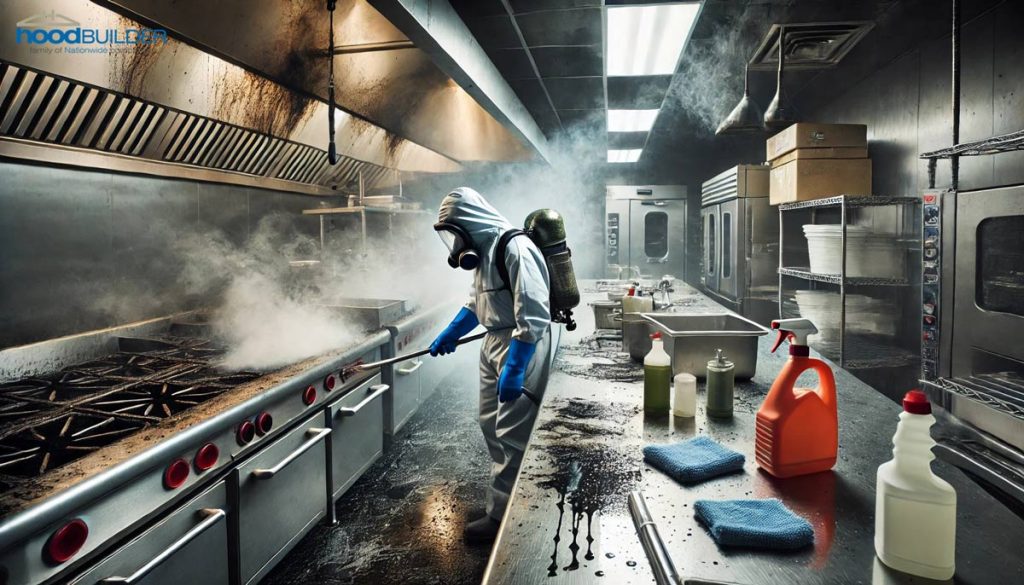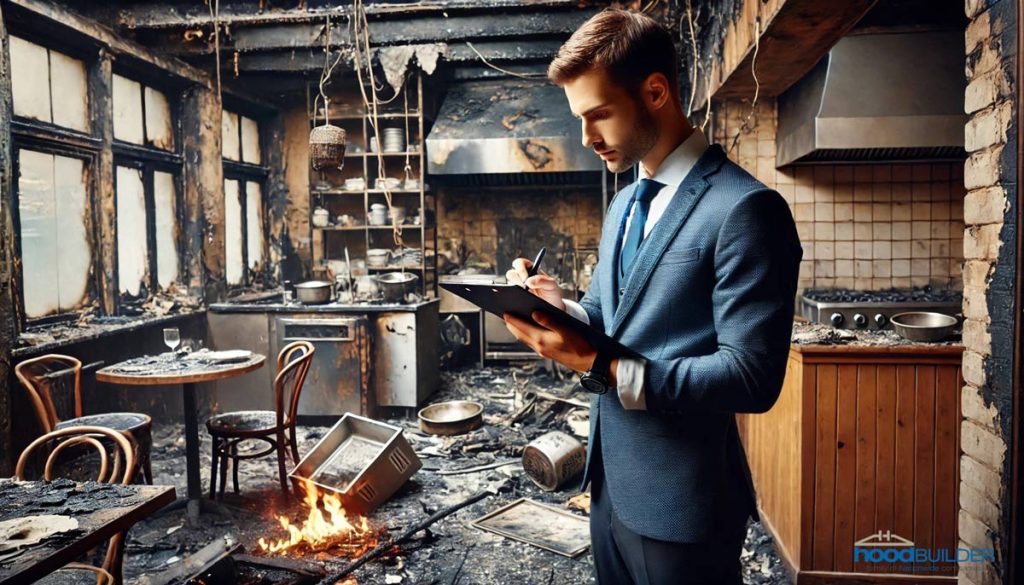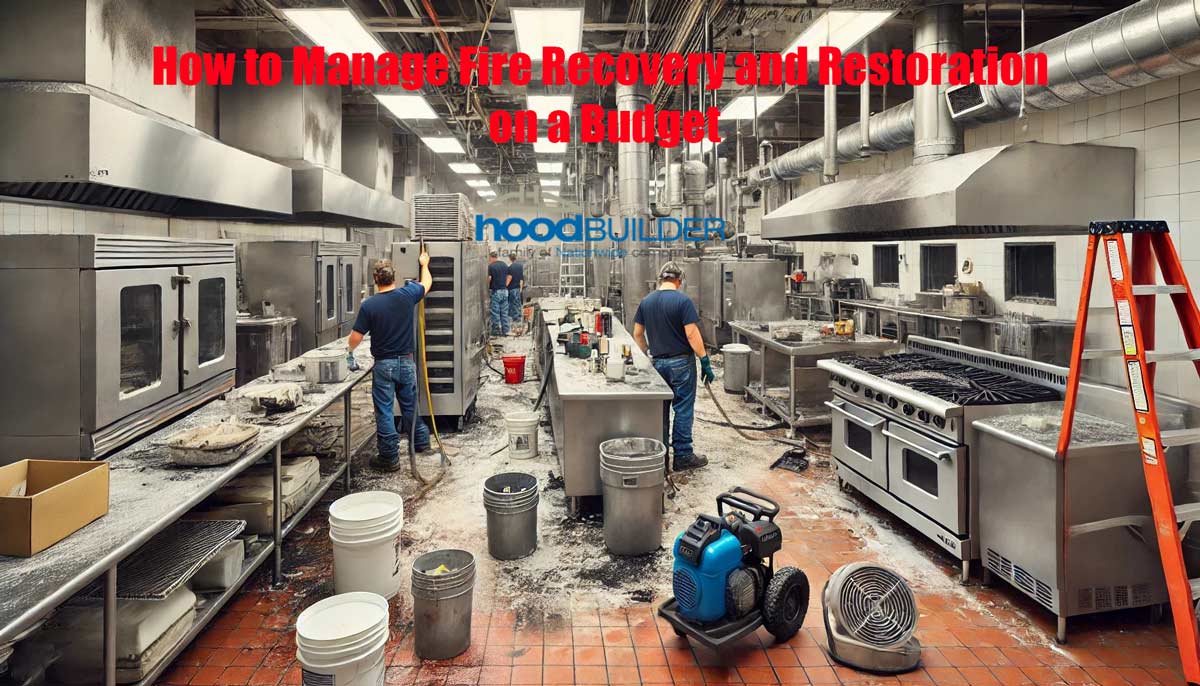Fires are an unfortunate reality for many restaurants, food trucks, and commercial kitchens. Despite stringent fire safety protocols, accidents happen, and the aftermath can be overwhelming. According to the National Fire Protection Association (NFPA), an average of 7,410 structure fires occur annually in eating and drinking establishments in the U.S., causing millions in damages.
The key to overcoming this challenge lies in preparation and timely action. Fire recovery and restoration are not just about repairing the visible damage; they are about ensuring the sustainability of your business. Whether it’s dealing with smoke and soot damage, structural repairs, or financial burdens, how you respond can make all the difference.
This comprehensive guide will provide actionable strategies to help you navigate fire recovery on a budget, ensuring your restaurant is back in business swiftly and cost-effectively. From cleanup tips to cost management and expert assistance, we’ve got you covered.
Fire damage shouldn’t derail your business. Contact Hood Builder at 303-777-7720 for Denver’s most reliable fire restoration services. Our experts are available 24/7 to provide affordable solutions tailored to your needs.
What Does Fire Recovery and Restoration Entail?
When it comes to fire recovery and restoration, knowledge truly is power. Understanding the critical steps involved can help you take control of the situation, minimize downtime, and manage costs effectively. Let’s dive into the key aspects of fire recovery and restoration and how each step contributes to getting your restaurant back to full operation.
1. Smoke and Soot Damage Cleanup

One of the most immediate impacts of a fire is the buildup of smoke and soot, which can permeate walls, ceilings, and equipment. Beyond being unsightly, smoke and soot can cause long-term damage if not addressed promptly.
Why it’s important:
- Smoke residue can corrode metal surfaces, damage electronics, and stain walls permanently.
- Left untreated, soot can impact air quality and pose health risks for employees and customers.
Actionable Steps:
- Hire professionals to clean and neutralize affected surfaces.
- Replace any items that cannot be salvaged to ensure safety and compliance.
2. Planning and Prioritizing Repairs
After the initial cleanup, the next step is assessing the damage and determining what needs repair versus replacement. This involves prioritizing repairs that will enable your business to reopen as quickly as possible.
Key Focus Areas:
- Structural Repairs: Evaluate the integrity of walls, floors, and ceilings.
- Kitchen Equipment: Identify critical appliances that need immediate attention to resume operations.
- Furniture and Décor: Determine which items can be restored to save costs.
Pro Tip: Always create a detailed plan with a timeline for repairs. Start with what’s necessary to meet health and safety standards, followed by aesthetic improvements.
3. Leveraging Insurance and Financial Assistance
Navigating the financial side of fire recovery can be daunting, but it’s a crucial part of the process. Your insurance policy is your best ally, so ensure you’re familiar with your coverage and ready to provide all necessary documentation.
Steps to Maximize Coverage:
- Document all damages with photos and detailed descriptions.
- Work closely with your insurance adjuster to ensure nothing is overlooked.
- Explore additional financial assistance options if needed, such as small business loans or grants.
Pro Tip: Keep a copy of your fire safety and maintenance records. These documents can strengthen your insurance claim by demonstrating due diligence.
4. Hiring Professional Help on a Budget
While it may be tempting to manage fire recovery on your own, professional restoration services can save time, money, and stress in the long run. Experts not only bring the right tools and expertise but can also guide you in making cost-effective decisions.
Choosing the Right Partner:
- Look for companies that offer customizable packages to fit your budget.
- Seek out reviews and testimonials to ensure you’re hiring a reputable provider.
- Consider companies like Hood Builder, which specialize in restaurant fire restoration and understand the unique needs of commercial kitchens.
By understanding these essential steps, you’ll be better equipped to handle fire recovery with confidence. Whether it’s removing smoke damage, repairing your kitchen, or navigating insurance claims, the right plan can make a challenging situation manageable.
Fire Damage Restoration Cost Estimates for 2025
One of the biggest concerns for restaurant owners after a fire is the cost of recovery. While fire restoration can be expensive, understanding the potential expenses and how to manage them is key to staying within budget. This section provides an overview of common restoration costs for commercial kitchens in 2025 and how you can make informed decisions to minimize your financial burden.
Breakdown of Typical Fire Restoration Costs
Below is a detailed look at the average costs associated with fire recovery and restoration services. Please note that actual costs can vary based on factors such as the size of your establishment, the severity of the damage, and your location.
| Action | Price Range * |
| Fire Damage Assessment | $500 – $2,000 |
| Smoke and Soot Cleanup | $1,500 – $5,000 |
| Structural Repairs | $10,000 – $100,000+ |
| HVAC Cleaning and Restoration | $2,500 – $10,000 |
| Kitchen Equipment Replacement | $5,000 – $50,000+ |
| Furniture and Décor Restoration | $3,000 – $15,000+ |
| Electrical System Repairs | $5,000 – $20,000+ |
| Plumbing Repairs | $2,000 – $10,000+ |
| Deep Cleaning and Sanitization | $2,000 – $8,000 |
| Permits and Inspections | $500 – $3,000 |
| Temporary Relocation Costs | $5,000 – $25,000+ (monthly) |
| Loss of Business Revenue | Based on revenue |
| Insurance Deductible | Typically $500 – $10,000 |
Key Factors That Influence Costs
Understanding what affects these costs can help you budget more effectively and prioritize spending.
- Extent of Fire Damage:
- A fire confined to one area will cost significantly less to restore than one that impacts the entire building.
- Size of the Business:
- Larger spaces require more materials, labor, and time, increasing overall costs.
- Type of Equipment and Furnishings:
- High-end kitchen equipment and custom furnishings can increase repair and replacement expenses.
- Location:
- Restoration costs may vary depending on local labor rates, materials, and permits.
- Insurance Coverage:
- The extent of your insurance policy will significantly impact out-of-pocket expenses.
Tips to Minimize Costs Without Compromising Quality
- Get Multiple Quotes:
- Always obtain estimates from at least three restoration companies to compare prices and services.
- Focus on Essential Repairs First:
- Prioritize structural and operational repairs that are critical to reopening your restaurant.
- Use Insurance Strategically:
- Work closely with your insurance adjuster to ensure all covered damages are accounted for.
- Opt for Partial Replacements:
- Instead of replacing everything, consider repairing items that can still function effectively.
- Hire Specialists:
- Companies like Hood Builder specialize in fire restoration for commercial kitchens, providing cost-effective solutions tailored to your needs.
Why Professional Restoration Services Are Worth It
While some restoration tasks may seem manageable on your own, hiring professionals ensures the job is done right the first time, saving you money in the long run. Professional services also help you navigate complex tasks like permit acquisition, insurance claims, and compliance with local safety regulations.
Worried about fire restoration costs? Hood Builder offers tailored recovery plans to suit your budget without compromising quality. Contact us at 303-777-7720 today for a free consultation and cost estimate!
Get Back to Business in No Time
When a fire disrupts your restaurant, food truck, or commercial kitchen, getting back to business quickly is critical. Every day of downtime translates to lost revenue, customer dissatisfaction, and potentially lasting harm to your reputation. The good news? With the right strategies and professional help, you can minimize downtime and restore operations efficiently.
Here’s how to ensure your recovery is swift, seamless, and budget-friendly.
1. Address Smoke, Soot, and Water Damage Immediately
Time is of the essence when dealing with post-fire cleanup. Smoke and soot can cause progressive damage, while water from sprinklers or firefighting efforts can lead to mold and structural deterioration.
Action Plan:
- Hire professionals for smoke and soot removal to prevent permanent staining and corrosion.
- Begin water extraction and dehumidification promptly to avoid secondary damage.
Why It Matters:
Quick action protects your restaurant’s structural integrity, prevents health hazards, and ensures a safe environment for employees and patrons.
2. Focus on Safety and Compliance
Before reopening, ensure your establishment meets all local health and safety regulations. Fire damage can compromise essential systems, and reopening without addressing these issues can lead to fines or further downtime.
Key Steps:
- Conduct inspections of HVAC systems, fire suppression equipment, and electrical wiring.
- Schedule necessary permits and inspections as part of your recovery plan.
Pro Tip: Work with experts like Hood Builder who understand the specific compliance requirements for commercial kitchens.
3. Prioritize Essential Repairs and Replacements
A well-structured repair plan is critical to reopening quickly. Focus first on repairs or replacements that directly impact your ability to serve customers.
Critical Areas to Address:
- Kitchen Equipment: Ensure stoves, ovens, and refrigeration units are functional.
- Dining Areas: Restore seating and décor to create a welcoming environment for customers.
- Plumbing and Electrical Systems: Verify that these systems are operational and safe.
Pro Tip: When choosing between repair and replacement, consider long-term efficiency. Upgrading to more fire-resistant or energy-efficient equipment may save costs in the future.
4. Leverage Insurance Effectively

Your insurance provider is a valuable ally in your recovery process. Properly documenting damages and understanding your policy’s coverage can significantly reduce your out-of-pocket expenses.
Steps to Maximize Your Claim:
- Take clear, detailed photos of all damage immediately after the fire.
- Maintain receipts for any temporary fixes, equipment rentals, or relocations.
- Partner with a restoration company like Hood Builder that can provide detailed reports and estimates to support your claim.
5. Communicate with Customers
Transparency is key to maintaining trust with your customers. Let them know about your recovery process, expected reopening date, and any changes to operations.
Communication Tips:
- Use social media to provide updates and engage with your audience.
- Offer discounts or promotions when you reopen to welcome customers back.
- Share behind-the-scenes photos of your recovery to build a sense of community.
6. Plan for the Future
Once your business is operational again, take proactive steps to prevent future incidents.
Long-Term Strategies:
- Upgrade fire suppression systems and HVAC units.
- Schedule regular maintenance and cleaning to reduce fire risks.
- Train your staff on fire safety protocols, including how to handle emergencies.
Pro Tip: Create a fire recovery checklist so you’re prepared if another incident occurs.
Frequently Asked Questions About Fire Recovery and Restoration
What Are the First Steps to Take Immediately After a Fire in a Restaurant?
Ensure safety, contact your insurance provider, and call a professional restoration service like Hood Builder to assess the damage and start cleanup. Document everything for insurance claims.
How Can I Minimize Costs During Fire Recovery and Restoration?
Focus on essential repairs, maximize insurance coverage, and work with a budget-friendly restoration company. Repair items when possible instead of replacing them.
How Do I Prioritize Repairs After a Fire?
Address safety-critical repairs first, like structural integrity, electrical systems, and kitchen equipment necessary to resume operations.
Can I Repair or Replace Equipment on a Budget?
Yes, many items can be repaired instead of replaced. Consult professionals like Hood Builder for affordable solutions.
How Does Insurance Play a Role in Fire Recovery?
Insurance can cover significant costs, but you must provide documentation of damages and follow their claim process closely.
Are Affordable Professional Fire Restoration Services Available?
Yes, companies like Hood Builder offer customizable services to fit your budget and recovery needs.
How Can I Prevent Significant Downtime After a Fire?
Act quickly, prioritize critical repairs, and hire a professional team to streamline the recovery process.
What Should I Look for When Hiring a Fire Restoration Service?
Choose a service with proven experience, good reviews, and comprehensive offerings, including inspections, cleanup, and compliance support.
How Long Does Fire Recovery Typically Take?
Recovery time varies from a few weeks to several months, depending on the damage and size of the business.
Can HVAC Systems Be Restored After Fire Damage?
Yes, most HVAC systems can be repaired or cleaned. Professional restoration ensures they are safe and functional.
What Steps Can I Take to Prevent Future Fires?
Upgrade fire suppression systems, train staff on fire safety, and schedule regular maintenance for equipment and ventilation systems.
Bottom Line: Denver’s Trusted Partner in Fire Recovery
Fire incidents can be devastating for restaurants and commercial kitchens in Denver, but they don’t have to halt your business permanently. The key to bouncing back lies in being prepared, acting quickly, and partnering with experts who understand the unique challenges of fire recovery in the Denver area.
With Denver’s vibrant dining scene, keeping your business operational and safe is essential. By understanding the fire recovery process—cleanup, structural repairs, and insurance claims—you can protect your investment and serve your loyal customers once again.
Being proactive is vital. Regular maintenance, upgraded fire suppression systems, and staff training specific to Denver’s local fire safety regulations can significantly reduce risks and ensure long-term sustainability.
Why Choose Hood Builder in Denver for Fire Recovery?
Hood Builder has been serving the Denver restaurant community with reliable, affordable fire recovery services for years. We understand the unique needs of local businesses and offer tailored solutions to help you get back on your feet quickly.
- Comprehensive Services: Smoke and soot cleanup, HVAC restoration, and compliance with Denver’s safety codes.
- Affordable Plans: Local, budget-friendly options designed for Denver-area restaurants.
- Expert Support: Assistance navigating insurance claims and Denver-specific permits and inspections.
- Available 24/7: We’re always ready to respond, no matter when disaster strikes.
Denver’s restaurant community thrives on resilience and innovation. Let Hood Builder help you rebuild stronger and smarter.
Call to Action: Denver’s #1 Fire Recovery Team
Don’t let fire damage hold your Denver business back. Call Hood Builder today at (303) 777-7720 for a free consultation and customized recovery plan. With Hood Builder by your side, you’ll be back to serving Denver’s diners in no time!

